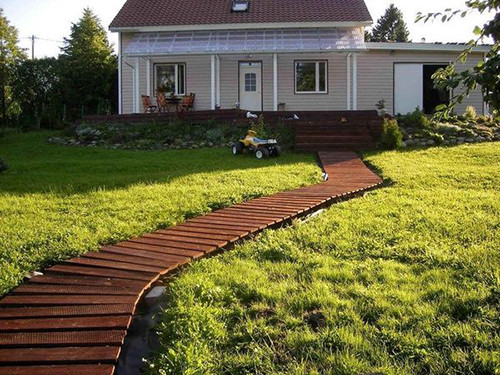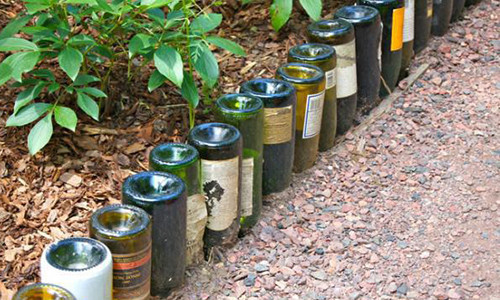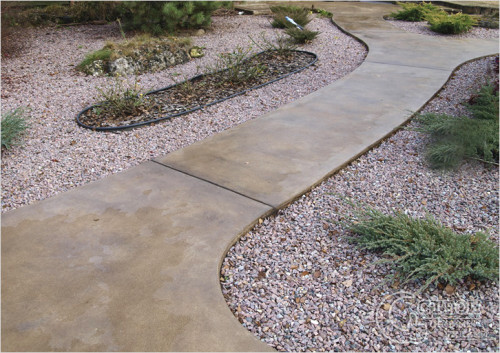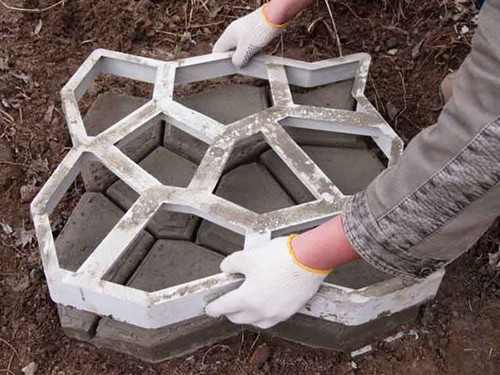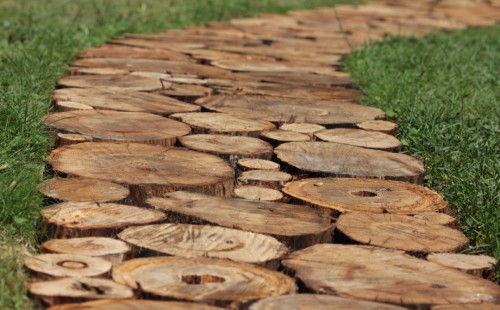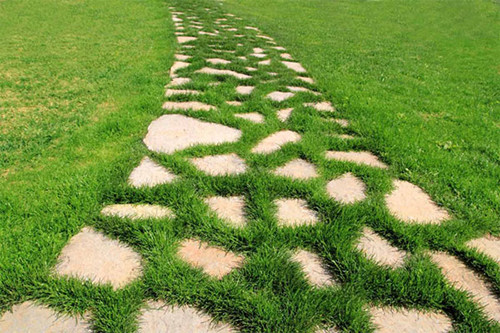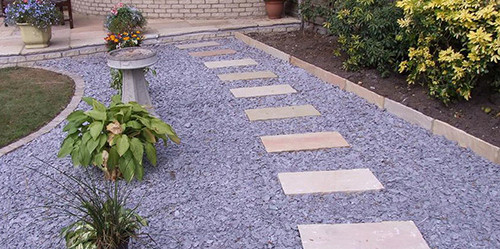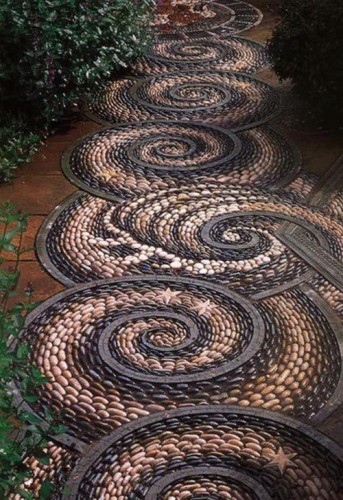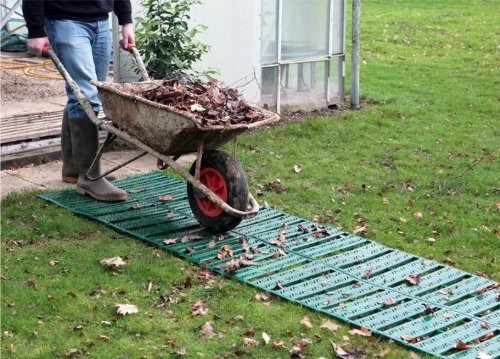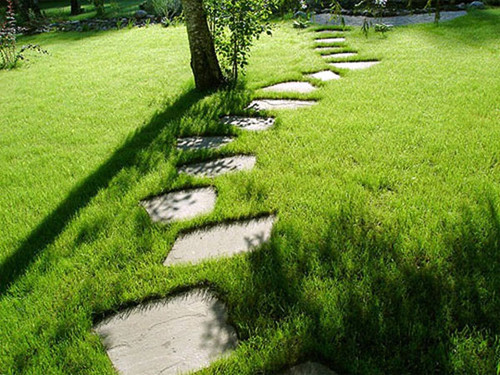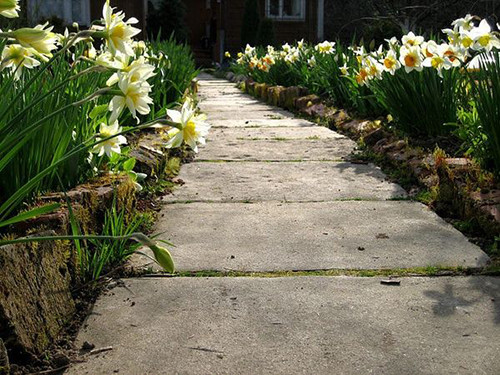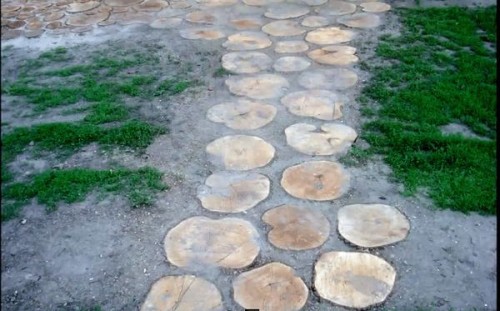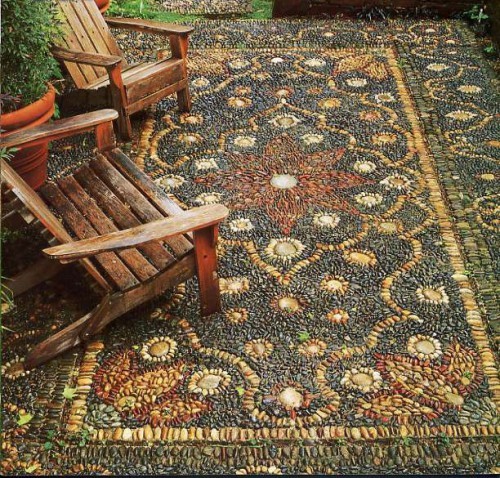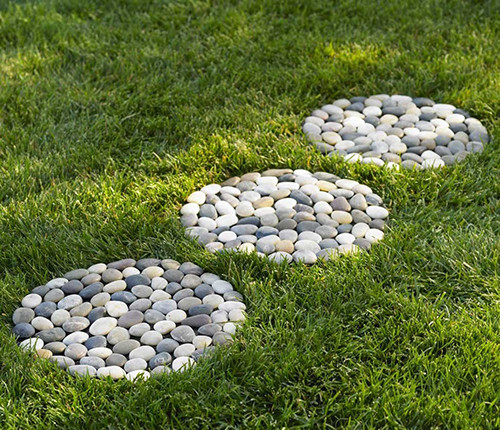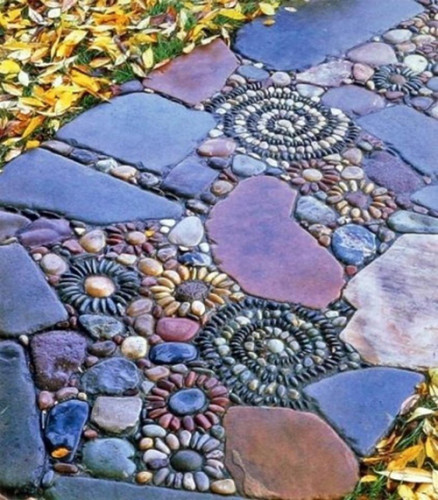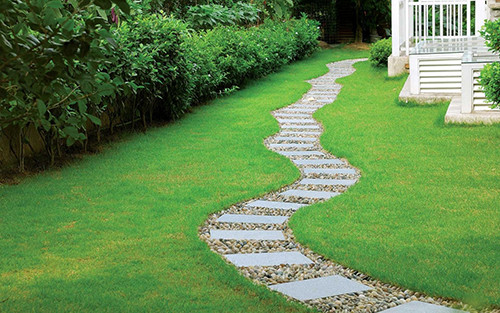Garden paths are the first thing a person sees when entering the site. As a rule, at first they appear completely spontaneously and almost independently - the owners themselves trample the ways to strategically important objects. However, with the very first rains, this state of affairs ceases to delight and bring convenience - neat paths turn into dirty mess, which is very inconvenient to move along. Therefore, sooner or later the question arises of the manufacture of a garden path. Moreover, it is always extremely desirable that the costs of this event are minimal. In this article you will learn how to lay the paths on your site cheaply and beautifully.
Content
Types of garden paths: select the appropriate
There are so many types of garden paths that it would not be one hour to transfer, so we decided to dwell only at the most practical, inexpensive and easy -to -do. Fortunately, there are more than enough materials for this. Most of the designers agree that the gardening paths should be paved precisely by the material from which a residential building is built - this technique allows you to create a harmonious general view of the site. In addition, after the construction there is probably a bunch of excesses: boards, logs, stones, bricks, cement ... Do not rush to store all this in the barn, but let the comfortable paths build before the rain season.
Garden paths
Garden paths are exactly the spontaneous phenomenon that we have already told about. If you live in the region with an arid climate, they may well serve year -round, without delivering special inconvenience. However, the inhabitants of the middle strip do not shine such happiness-you still have to pick up tools and materials in order to come up with something more practical.
The garden path can be used as a temporary option or left a couple of short paths to the flower beds and the garden, the visit of which is relevant only in the warm season. In order to ennoble and highlight the path, you can put cobblestones, bricks at its edges, stick glass bottles with the neck down or plant the so -called border plants.
Running paths
One of the most budget options is the garden path from gravel backfill. To make such a route, you need to dig a trench of a convenient width with a depth of about 10 cm, linen the bottom and walls with geotextiles, strengthening it on the sides of a curb ribbon. Pour gravel, screening, pebbles or marble crumbs on top. That, in fact, is all. It remains only to compact the resulting embankment.
If this option seems too simple to you, large stone or concrete tiles can be laid on top of the emboss. This method will be described in more detail below.
Concrete flood paths
If on the site you work with large and heavy garden equipment, the paths are regularly subjected to serious loads, and with the first rains the wheels will certainly get bogged down in blurry soil. The best solution to this problem will be pouring paths with concrete. But the gray coating may seem too boring and ugly, so we offer to “inlalate” it with decorative elements: tiles, pebbles, mosaics, multi -colored glass found on the sea, etc.
How to make a garden path from concrete:
- Make markings on the ground, indicating the width and length of the future path.
- Drink the pit in accordance with the marking with a depth of about 10 cm.
- At the bottom of the trench, pour sand with a layer of 5-6 cm thick, sprinkle with water from the hose and ram it properly.
- Build the formwork along the entire length of the track, setting the plank or plywood frames at a distance of 5-6 cm from each other. The width of each frame should be the same as the width of the track. Optimal dimensions for concreting in this case: 60x60 cm.
- Prepare a classic cement-sand solution in a proportion of 1 part of the cement not lower than M300 by 3 parts of sand. First, mix bulk ingredients, and then add water a little until the mixture reaches a homogeneous consistency of thick sour cream.
- Pour the solution into the formwork and wait for it to slightly dry.
- Put decorative elements on the surface, drowning them a little in concrete.
- Leave the track to dry for 2-3 days.
- Unpretentious lawn plants can be planted between the plates.
Perhaps concrete paths created using special shapes can be attributed to the same type. You can buy such in any construction store, spending no more than a thousand rubles on this. But to make the case move quickly, it is better to purchase 3-4 forms.
Useful advice: most forms for paths have standard sizes of 60x60 cm, which is quite enough for a narrow path, along which it is convenient to walk. But if you need a wider road, just use two forms by placing them to come on - you get a path of 120 cm wide. Some masters prefer to make forms for garden paths with their own hands, which allows them to move away from standard shapes and sizes.
How "works" a form for a garden path:
- Mark on the ground to indicate the length and width of the future path.
- Dry the trench along the entire length of the path 10 cm deep.
- Level and compact the bottom thoroughly.
- The bottom is strewn with a gravel or crushed stone with a layer of 3-4 cm thick.
- Pour 5 cm layer of small river sand over the crushed stone, sprinkle with water and compact.
- Lubricate the forms for the paths with expert or machine oil. If there was no one, you can use the cheapest vegetable oil.
- Install the forms on the sand.
- Knead a solution of 1 part of cement not lower than M300, 3 parts of sand and 4 parts of gravel. It is even better to add a special connecting composition for foundations. Then add water portioned to bring the mixture to the desired consistency. If you want to make a colored track, add a special dye.
- Arm with a trowel and fill the forms to the very edges, trying to prevent the appearance of air voids inside (they greatly reduce strength).
- Remove the excess solution with a plastic rail-right and leave the form at rest for 30-40 minutes.
- Gently lift the forms so as not to violate the barely seized concrete and repeat the procedure, thus moving along the entire length of the trench. If you smell the forms of oil properly before pouring them with concrete, they will separate quite easily. Do not forget to lubricate them every time.
Now it is important to be patient and drive away children and pets from the hardening path for the next 2-3 days.
Wooden log paths
One of the most inexpensive and adored by summer residents is garden paths from wooden beams, boards and saws. If the climate in your region is quite dry, you can safely take up work. To create such paths, it is best to choose solid wood of wood, ideally - larch (it is not susceptible to decay). The level of paths is usually slightly raised above the ground, so water does not linger on their surface and there is a minimum of dirt. Massive beams soaked in an antiseptic composition that prevents rotting are supported as a support.
Brief instructions for creating a path made of wood:
- Mark the future path.
- EXC the trench in accordance with the marking of 10 cm deep.
- Pour a layer of gravel or crushed stone with a thickness of 5 cm to a flat tamped earthen bottom.
- On gravel, lay a wooden flooring with a distance of 1-2 cm between the elements. If you place them, the code will linger in the cracks and rather ruin the wood.
- If there are old trees in the country, which it is time to cut it long, they can be launched on beautiful and unusual paths. Sprinkle the trunks into rounds and lay them out garden paths. You will get a kind of wooden tile. Such elements look very beautiful on the lawn when green grass breaks between them. The gaps between large rounds can be filled with crushed stone or spits of small branches.
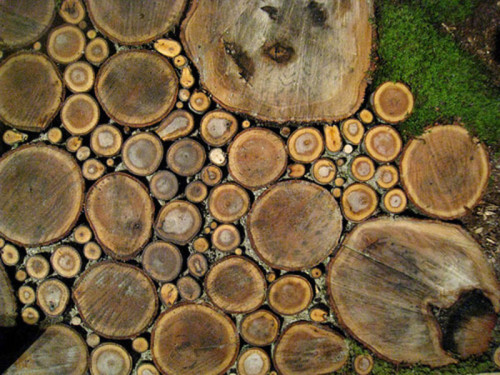
To extend the life of wooden paths, all elements must be impregnated with hot olifa twice, and between the gravel pillow and soil, lay geotextiles. Below is on the video - Garden paths with your own hands from wooden saws:
With your own hands in the garden: master classes
In this chapter, we will tell in detail how to make neat paths with your own hand and harmoniously fit them into the natural landscape. As you will see soon, for this you do not need to use expensive materials, and in the last master class the gifts of nature are completely used.
Large stone tile
Such a path will appeal to those who prefer simplicity bordering on primitiveness. Large stone slabs, between which lawn grass breaks out very unobtrusive and at the same time are a functional and comfortable landscape element. The styling technique will not require you of inhuman physical exertion or abundance of consumables. For work, you will need large tiles, paint in the spray can of orange or white (for contrast marking), a construction water level, a shovel, a roulette, river sand and several boards, the length of which is equal to the width of the path.
How to make garden paths with your own hands with low costs:
- Mark the future path. To do this, lay down the wooden boards (track width) across, and stretch the twine or hose (track direction) along them. The distance between the boards should be about 50 cm.
- Along the twine or hose, draw a line from the cylinder paint, after which you can remove the auxiliary elements.
- Calculate the total area of \u200b\u200bthe path in m² and prepare the required number of plates.
- Lay the slabs as you would like to see them in the final result. It is not necessary to lay them evenly - it is best to scatter as chaotical as possible, but at a small distance from each other so as to create the effect of carelessly folded mosaics. Try to withstand the distance between the slabs at 8-10 cm.
- Circle each plate with paint from the cylinder.
- Raise one of the plates and put aside. Now, using a shovel with a rounded point, carefully remove the upper layer of soil with the grass and roots. First, pierce the turf according to the marking, and then pick it up and cut it. You should get a neat hollow in accordance with the shape of the stove.
- Put the stove in a hollow and continue this exciting activity until all the plates are slightly drowned in the grass.
- Carefully compact the slabs and check that they are located on the same level. If any of the stones will be above others, you will definitely stumble about it all the time. If necessary, remove the right amount of land or add sand to the bottom of the hollow.
Stones are compacted in a completely natural way. What is convenient - you can immediately walk along the path without waiting for drying and not afraid to destroy it with a careless movement.
Soil path with square slabs
Such a garden path in the country can visually expand and “unload” space. Unlike the option described above, it looks more neat and modern. Its styling will also not require any special skills or great efforts. The most important thing is to make even marking along the width and length, and then find the area and buy enough material. For example, if you want to make a path 100 cm wide and 8 m long, then its area will be: 1*8 \u003d 8 m².
To work, you will need square stone slabs 30x30 cm, gravel or gravel for drainage pillows, river sand, wooden pegs and twine for marking, roulette with a level, a shovel. For tamping, you can use a special vibration tool, but if you could not find one, use the usual heavy log. Also, resourceful craftsmen tie wide boards to the soles of the shoes and walk on the surface, crushing it with their own weight.
Important: withstand the distance between the plates and the edges of the track 8-15 cm to provide high-quality drainage and ventilation.
Putting such a path is very simple. First, make markings with pegs and twine, then get a trench, compact the bottom, pour sand and gravel, and then compact again. Put the plates, pour the gaps with gravel and again tamp it, watering a little water from the hose.
Garden track from pebbles
Paths from concrete slabs are good, but these plates should be bought in a store, and then also somehow delivered to the site. If you have a happiness to live near the river or sea, the shore of which is strewn with different-caliber smooth pebbles, we suggest that you use this master class. Please note that the general installation technology is set out here, which will help to firmly fix the elements. But in what order to do this and what patterns to lay out, solve only to you. At the end of the article you will find a photo of the garden paths of such a plan that may inspire you to create masterpieces.
So, for work you will need the following:
- pebbles (stones of different sizes and shades);
- fine sand;
- plywood;
- cement M300;
- gravel crumbs;
- construction level;
- hard brush;
- wooden kiyanka.
Before starting work, look at a bunch of pebbles brought from the shore, take a couple of hours and thoroughly sort the pebbles by size and color scheme - it will be very useful and save a lot of time if you want to create a beautiful pattern, even the easiest. Rinse stones from dirt - you only need to work with clean material.
Useful advice: If you want to lay out a track with a pattern or pattern, it is better to throw a sketch on paper in advance. After that, on a piece of plywood or tarpaulin, put an approximate pattern of stones, having them as you see them in the final result. Then take a picture of the composition and try to reproduce it already with finishing laying.
Laying technology:
- Mark the future path and dig a trench with a depth of about 20 cm.
- At the bottom, pour a mixture of gravel crumbs, cement and sand with a thickness of 5 cm (about 1 bag of concrete mixture takes 10 m² of track).
- Pour the pouring from the hose so that it stops dusting.
- If you lay out the mosaic in circles, use the proven tricks - tie a rope to a long nail or pencil, place its opposite end in the alleged center, stretch and scratch on the ground an even circle, draw a nail (pencil) around the circle with equal tension of the rope. Changing the length of the rope, you can make circles of different diameters.
- For reliable fixation of pebbles, bury the first elements in concrete by a third. The first stone should always be placed strictly vertically.

- Around the first stone in the center with a small spatula, you need to dig small holes in which the drawing will methodically lay out.
- Make sure that the joints between the elements are as strong as possible, and the stones fit tightly to each other.
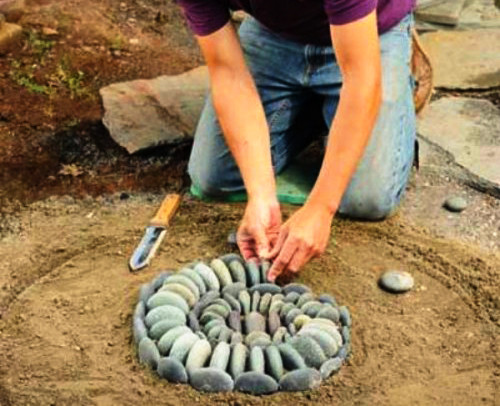
- Constantly check the horizontal masonry level - this is the most important. Otherwise, you will constantly stumble on the path and quickly knock out the interfering stones, breaking the composition. To adjust the height, beat the stones with a egg.
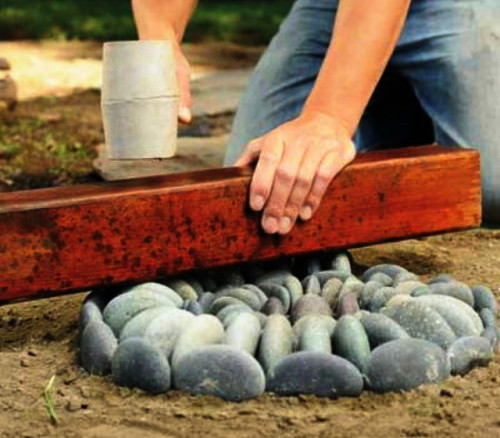
- After the composition is completed, make a way a path of large stones, tiles or bricks so that it acquires a neat and complete look.
- In the cracks between the stones, pour cement with small sand, moisten and cover for a day with plastic film or tarpaulin so that the concrete is properly saturated with moisture, but not dry.

- After a day, forget the concrete mixture between the pebbles so that only a third sticks outside, and two -thirds are underground. If you score concrete even more, so that only the tops of the elements peep out, such a path will last even longer.
- Once again, moisturize the concrete, watering it from the hose. If it gives a strong shrinkage, add the right amount of the mixture.
- Take a hard brush (not metal) and form neat seams between pebbles.
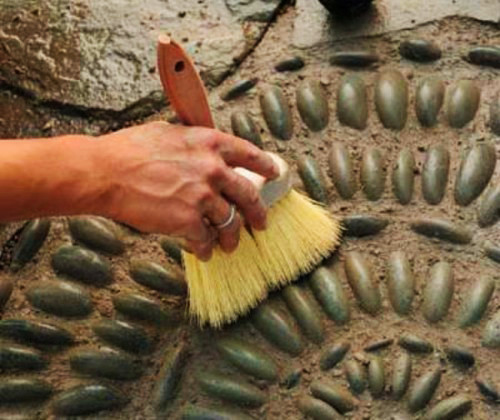
Put the almost finished path with a tarp and leave for a couple of days. The mosaic will dry out completely after a couple of weeks, so gain patience and try not to destroy beauty ahead of time.
Useful tips
As you can see, there is nothing complicated here. You can use improvised materials and gifts of nature or just buy plastic garden paths without bothering yourself with physical exertion. By the way, such products are distinguished by mobility that are not inherent in the above analogues - they can be removed in dry weather and at any time lay in any direction.
Finally, we offer to get acquainted with useful tips that can be useful when creating tracks in the country:
- Walking paths look very neat. Such paths consist of disparate elements, for example, large square or round plates, stones, wooden saws. But transporting garden equipment on them is strongly inconvenient - they are suitable only for hiking.
- Feel free to use a variety of materials. The stone goes well with the tree, so the gravel looks harmoniously with the boards and logs, and narrow paths from pebbles can scatter from the central slab path.
- Before starting construction, especially if concrete participates in it, take an interest in the weather forecast. It is best if no precipitation is expected in the coming week. Then the path will have time to completely dry and harden properly. But for simple crushed stone adds, a short -term “mushroom” rain will be very useful - it will finally compact the surface and kill dust.
- If you like natural asymmetry and a variety of forms, use a natural unprocessed stone. Beautiful curved paths are made from it, winding between fruit trees and berry bushes.
Whatever path you build, you need to properly care for it, otherwise the joy of walks along clean, even paths will not last long. You will find all the necessary information on this issue in the article "Care for the garden path".
DIY garden paths: photo
We have prepared a small photo selection for you, in which we tried to fit the most original and, most importantly, examples of garden paths implemented in practice.

